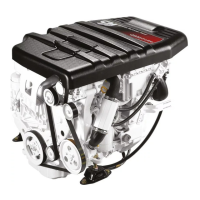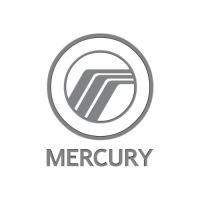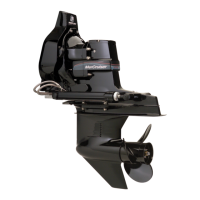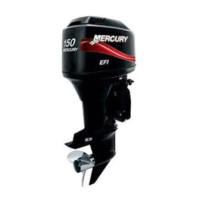Section 3 - On the Water
Page 32 90-8M0069751 eng APRIL 2012
Keep in mind that one of the most important things you can do to help reduce injury or impact damage in these situations is
control the boat speed. Boat speed should be kept to a minimum planing speed when driving in waters known to have
underwater obstacles.
After striking a submerged object, stop the engine as soon as possible and inspect the drive system for any broken or loose
parts. If damage is present or suspected, the power package should be taken to an authorized Mercury Diesel repair facility for
a thorough inspection and any necessary repair.
The boat should be checked for hull fractures, transom fractures, and water leaks.
Operating with damaged underwater drive components, rudder, or boat bottom could cause additional damage to other parts of
the power package, or could affect control of the boat. If continued operation is necessary, do so at greatly reduced speeds.
!
WARNING
Operating a boat or engine with impact damage can result in product damage, serious injury, or death. If the vessel
experiences any form of impact, have an authorized Mercury Marine dealer inspect and repair the vessel or power package.
Sterndrive Impact Protection
The power trim hydraulic system is designed to provide impact protection for the sterndrive. If a submerged object is struck
while the boat is moving forward, the hydraulic system will cushion the kickup of the sterndrive as it clears the object, reducing
damage to the sterndrive. After the sterndrive has cleared the object, the hydraulic system allows the sterndrive to return to its
original operating position, preventing loss of steering control and engine overspeed.
Use extreme caution when operating in shallow water or where underwater objects are known to be present. No impact
protection is provided in reverse; use extreme care to prevent striking submerged objects while operating in reverse.
IMPORTANT: Impact protection system cannot be designed to ensure total protection from impact damage under all
conditions.
Conditions Affecting Operation
Weight Distribution (Passengers and Gear) Inside the Boat
Shifting weight to rear (stern):
• Generally increases speed and engine RPM
• Causes bow to bounce in choppy water
• Increases danger of following wave splashing into the boat when coming off plane
• At extremes, can cause the boat to porpoise
Shifting weight to front (bow):
• Improves ease of planing
• Improves rough water ride
• At extremes, can cause the boat to veer back and forth (bow steer)
Bottom of Boat
To maintain maximum speed, ensure that the boat bottom is:
• Clean, free of barnacles and marine growth.
• Free of distortion, nearly flat where it contacts water.
• Straight and smooth, fore and aft.
Marine vegetation may accumulate when the boat is docked. This growth must be removed before operation; it may clog water
inlets and cause the engine to overheat.
Cavitation
Cavitation occurs when water flow cannot follow the contour of a fast‑moving underwater object, such as a gear housing or a
propeller. Cavitation increases propeller speed while reducing boat speed. Cavitation can seriously erode the surface of the
gear housing or the propeller. Common causes of cavitation are:
• Weeds or other debris snagged on the propeller
• Bent propeller blade
• Raised burrs or sharp edges on the propeller

